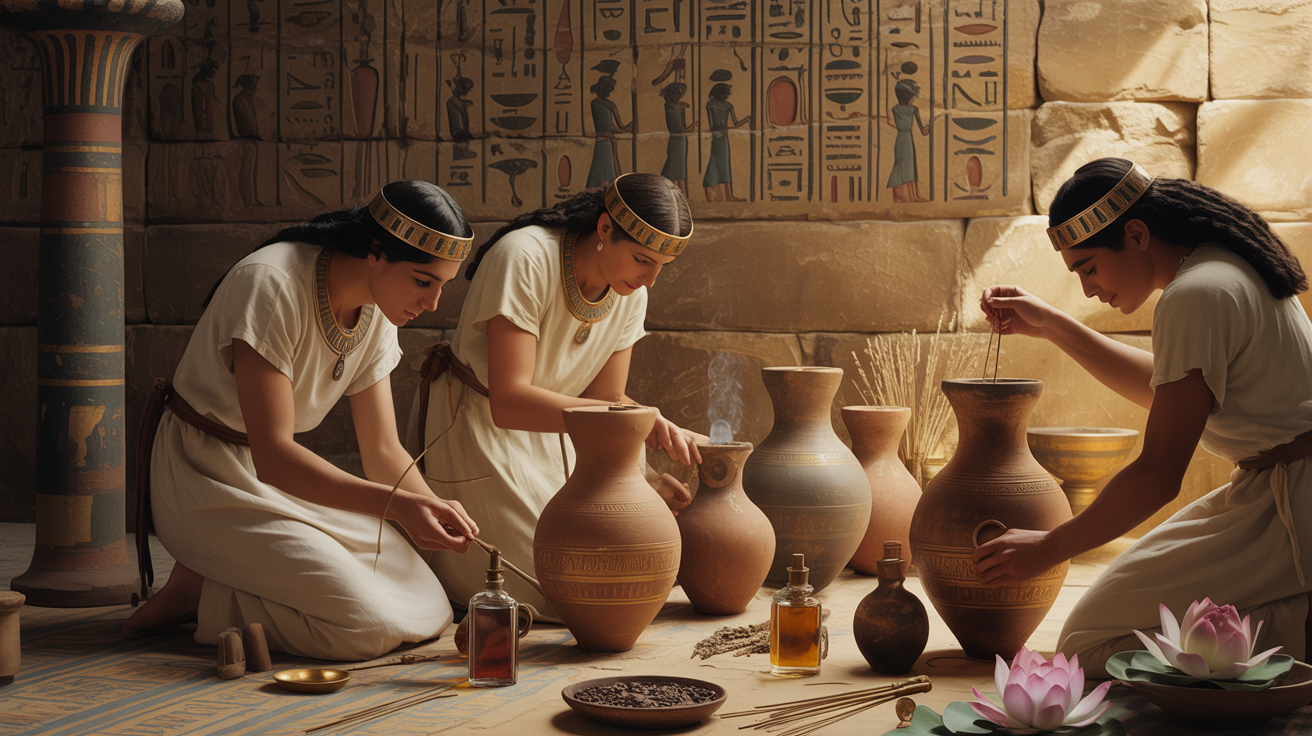
From Ancient Egypt to Modern Perfumery: A Journey Through Fragrance History
Explore the fascinating 5,000-year evolution of perfumery, from ancient Egyptian incense rituals to today's synthetic masterpieces. Discover how fragrance shaped civilizations and became the luxury industry we know today.
Perfume is one of humanity's oldest luxuries, with a history spanning over 5,000 years. This journey through time reveals how fragrance evolved from sacred ritual to personal expression.
Ancient Origins: Mesopotamia and Egypt (4000-30 BCE)
The world's first perfumes emerged in Mesopotamia around 4,000 BCE. Tapputi, a perfume maker mentioned in cuneiform tablets, is the earliest recorded chemist in history.
Egyptian Mastery
Ancient Egyptians elevated perfumery to an art form. They created incense for religious ceremonies, perfumed oils for embalming, and personal fragrances for daily use. Kyphi, a famous Egyptian incense blend containing 16 ingredients, was burned during evening rituals.
The Egyptian Process
Maceration: Flowers soaked in oils Enfleurage: Petals pressed into animal fats Distillation: Basic forms existed Resin burning: Frankincense and myrrh
Classical Antiquity: Greece and Rome (800 BCE - 476 CE)
The Greeks and Romans transformed perfumery from sacred to secular use.
Greek Contributions
Greeks imported Egyptian techniques and added scientific inquiry. Theophrastus wrote "Concerning Odours," the first written work analyzing perfume composition.
Roman Excess
Romans took perfume to extravagant heights. They scented everything: bodies, clothes, homes, and even their pet dogs. Emperor Nero allegedly spent the equivalent of $100,000 on roses for a single banquet.
The Islamic Golden Age (8th-13th Century)
Islamic scholars revolutionized perfumery through chemistry.
The Distillation Revolution
Al-Kindi wrote the "Book of the Chemistry of Perfume," documenting over 100 formulas. Persian polymath Avicenna perfected steam distillation, allowing extraction of rose oil—the most prized ingredient.
Rose Water Innovation
Persian rose water became so valuable it was used as currency. The technique spread throughout the Islamic world and into Europe via the Crusades.
Medieval Europe: Dark Ages to Renaissance (476-1600)
During the Middle Ages, perfume knowledge nearly disappeared in Europe but survived in monasteries.
The Black Death Impact
The plague paradoxically boosted perfume use. People believed strong scents prevented disease, leading to pomanders, scented gloves, and perfumed walking sticks.
Venetian Dominance
Venice controlled the spice trade, making it Europe's perfume capital. Catherine de' Medici brought Venetian perfumer René le Florentin to France, planting seeds for French dominance.
The French Revolution: Grasse Becomes the Perfume Capital (17th-18th Century)
Grasse, France, initially known for leather tanning, transitioned to perfume ingredient cultivation when scented leather gloves became fashionable.
Flower Fields of Grasse
Jasmine from India Rose from Turkey Lavender from local fields Tuberose cultivation
This agricultural foundation established Grasse as the world's perfume capital, a status it maintains today.
The Modern Era: Synthetic Revolution (19th Century)
The 1800s transformed perfumery through chemistry.
Synthetic Breakthroughs
1868: Coumarin synthesized (smells like vanilla) 1888: Heliotropin created 1889: Vanillin synthesized 1893: Ionones (violet scent) developed
These synthetics made perfume accessible beyond the wealthy elite.
Jacques Guerlain's Innovation
Guerlain's 1889 Jicky was the first perfume using synthetics alongside natural ingredients, creating a new olfactory landscape impossible with naturals alone.
20th Century: The Golden Age
The 1900s saw perfume become an art form and commercial powerhouse.
Iconic Launches
1921: Chanel No. 5 (Ernest Beaux) - First abstract perfume 1925: Shalimar (Jacques Guerlain) - Oriental masterpiece 1947: Miss Dior (Paul Vacher) - Post-war optimism 1966: Eau Sauvage (Edmond Roudnitska) - Fresh masculine 1977: Opium (Jean-Louis Sieuzac) - Controversial oriental 1985: Poison (Edouard Fléchier) - Bold statement 1992: Angel (Olivier Cresp) - Gourmand revolution 1996: CK One - Unisex mainstream
The Celebrity Era (1990s-2000s)
Celebrities licensing their names to fragrances created a new market segment. Elizabeth Taylor's White Diamonds became one of history's best-selling fragrances.
The 21st Century: Democratization and Niche
Modern perfumery splits into two distinct paths:
Niche Revolution
Brands like Le Labo, Byredo, and Maison Francis Kurkdjian focus on artistry over mass appeal. These houses prioritize quality ingredients and unique compositions.
Middle Eastern Disruption
Brands like Lattafa, Armaf, and Ajmal challenge Western dominance by offering luxury quality at accessible prices, leveraging social media for global reach.
Technology Integration
AI assists in formula creation Biotechnology creates sustainable alternatives Molecular science develops new aroma chemicals 3D printing customizes bottles
Sustainability Movement
Modern consumers demand:
Ethically sourced ingredients Eco-friendly packaging Cruelty-free testing Transparent supply chains Carbon-neutral production
The Future of Fragrance
Personalized Perfumery AI-driven custom formulations based on preferences and body chemistry.
Biotechnology Lab-grown rose cells and sustainable oud alternatives.
Digital Scent Research into transmitting smell digitally continues, though practical applications remain distant.
Conclusion
From Egyptian temples to TikTok reviews, perfume has evolved while maintaining its essential purpose: transforming the invisible into the unforgettable. Each era added layers to this art form, creating the rich, diverse fragrance landscape we enjoy today.
The next chapter is being written now, with technology, sustainability, and global cultural exchange shaping perfumery's future. One thing remains constant: humanity's eternal fascination with beautiful scents.
